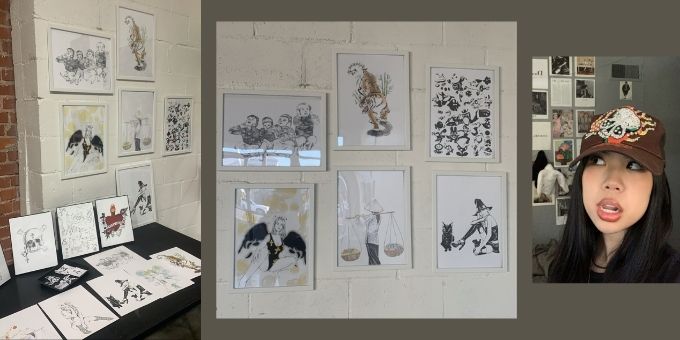Spotlight: artistic purpose & progress
Valerie is a visual artist pushing through boundaries to make a creative lifestyle for herself. She’s developed skills in graphic design, illustration, and clothing design.
Valerie’s spikeview helps her articulate her personal narrative. She took some time to share her insights about her artistic purpose and tracking the progress she’s making.

Why make art? What’s the satisfaction or drive?
Art was first a form that I got involved with to portray my ideas and feelings that I could not bring myself to present to the world. Feelings of loneliness or ideas of some mystified evil could be drawn out and held in my work.
I thought of my sketchbook as something of a therapist. I used to doodle a lot on papers, and friends would ask me to draw them. I drew more and more, both as a hobby and to practice my craft. I realized it made me much happier than I used to be.
The original idea of drawing out my feelings was pushed aside and I realized art-making had become a passion. Slowly when I shared my art to the world, I got good feedback and developed my own unique style of concepts, drawing, and shading.
Art then expanded to different forms, and made me push to expand my skills and knowledge so I can pursue a creative lifestyle.
Why is an arts portfolio so important?
A portfolio is essential for a visual artist like me because of its capability to display the lifelong progression and work that had gone into creating my pieces.
Any consumer or client would want to see what you are able to do and what you represent before deciding to work with you. Just like any employer would require a background check or ask for any past work experience in order to conduct that you are the right candidate for a position.
A portfolio is essentially the visual story of my history and experience as an artist. It’s the background check for someone considering hiring me for a commission. You can browse and observe the different works and show the amount of effort and time you have invested in your craft.
How to present yourself to clients looking for different types of art or design?
If clients are segmented, I don’t limit them to just a certain portion of my portfolio. I believe it’s a useful idea to show everything that you can do as long as it’s in the same general line of work.
I may do illustrations and graphic designs, and the client may have asked for a logo concept, however, I don’t see any reason to only show them a logo portfolio. Clients need to see my creative approach across disciplines.
When it comes to art, each segment is connected to one another in some way. I would like to present all my work to the client in order for them to understand my entire design journey and experience.
What type of commissions have you received?
At first, I charged just a couple dollars for a small tattoo design. Then I began getting commissions from underground artists who would pay me $20 to $30 for album covers to be posted on Soundcloud, Apple Music, etc. My commissions transitioned to logo designs and clothing designs that were printable.
My first big assignment was a commission from D.Hill. He produced music for rappers Lil Uzi Vert and Future, including Future’s hit song “Life is Good” featuring Drake. I created a logo for his brand High Hill and rebranded the Forever Broken clothing line of his cousin.
Progressively, I’ve gotten more commissions that made me learn Adobe Photoshop and Illustrator in order to understand the process of design. Multiple Instagram clothing brands have approached me to design certain concepts. Some brands are interested in purchasing illustrations of mine to sell products with their logo and name on it.
I started making designs for Rose In Good Faith, Eternal Art Wear, and more. As I’ve grown, I’ve been able to more than double my design prices, now in the $100 range. I still get commissions asking for drawings for certain things, but they have mainly been for clothing designs where I get to use my creative expertise to improvise on their original ideas.
How can your spikeview help grow your business to meet your creative lifestyle goals?
Having my business on spikeview, I am able to market my design portfolio to demonstrate my artistic journey, including experience and references. People who are interested can message me about commissions or just to talk with me about life as a young creative.
With knowledge on Photoshop and Illustrator, I can help others who want to learn more about these softwares or want to dig deeper in the art field. Not only does this benefit them but I can get more recognition and awareness as to who I am and what I do.


[…] internet is amazing. Teen artists who are just getting started can connect directly with customers. No more waiting to be […]